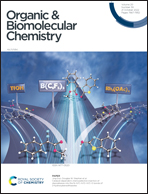Robust synthesis of 2′-azido modified RNA from 2′-amino precursors by diazotransfer reaction†
Abstract
Azides are versatile bioorthogonal reporter moieties that are commonly used for site-specific labeling and functionalization of RNA to probe its biology. The preparation of azido modified nucleic acids by solid-phase synthesis is problematic due to the inherent reactivity of P(III) species with azides according to the Staudinger reaction. Various strategies have been developed to bypass this limitation and are often time-consuming, low-yielding and labor-intensive. In particular, the synthesis of RNA with internal 2′-azido modifications is restricted to a single approach that employs P(V) chemistry instead of the widely used P(III) phosphoramidite chemistry. To fill this methodological gap, we present a novel convenient path toward 2′-azido RNA from readily accessible 2′-amino RNA through treatment with the diazotizing reagent fluorosulfuryl azide (FSO2N3). A diazotransfer reaction was established for oligoribonucleotides of different lengths and secondary structures. The robustness of the approach was further demonstrated for RNAs containing multiple 2′-azido moieties and for RNAs containing other sensitive modifications such as thiouridine or methylated nucleobases with a positive charge. The synthetic ease of generating 2′-azido RNA will pave the way for biotechnological applications, in particular for siRNA technologies and for referencing the growing number of RNA metabolic labeling approaches that rely on 2′-azido nucleosides.



 Please wait while we load your content...
Please wait while we load your content...